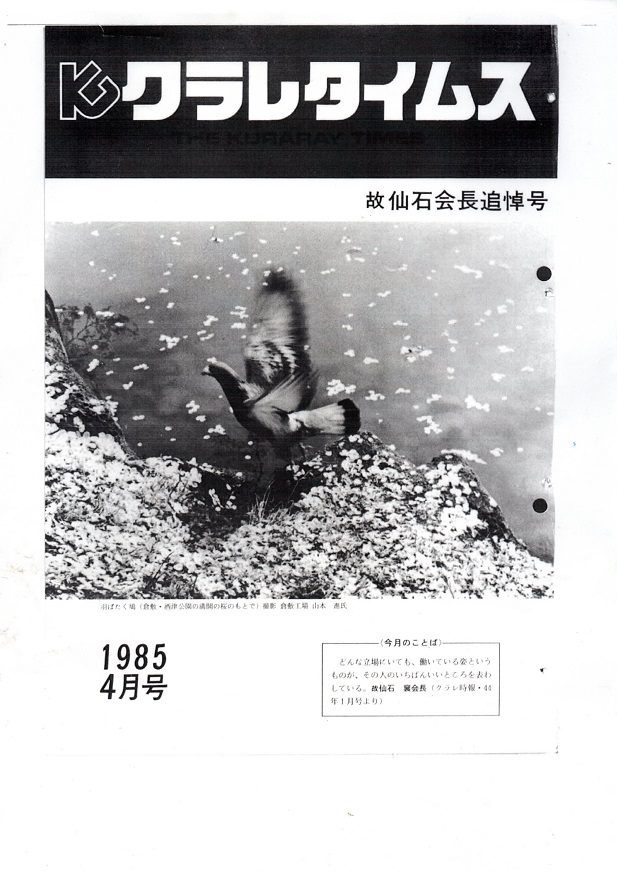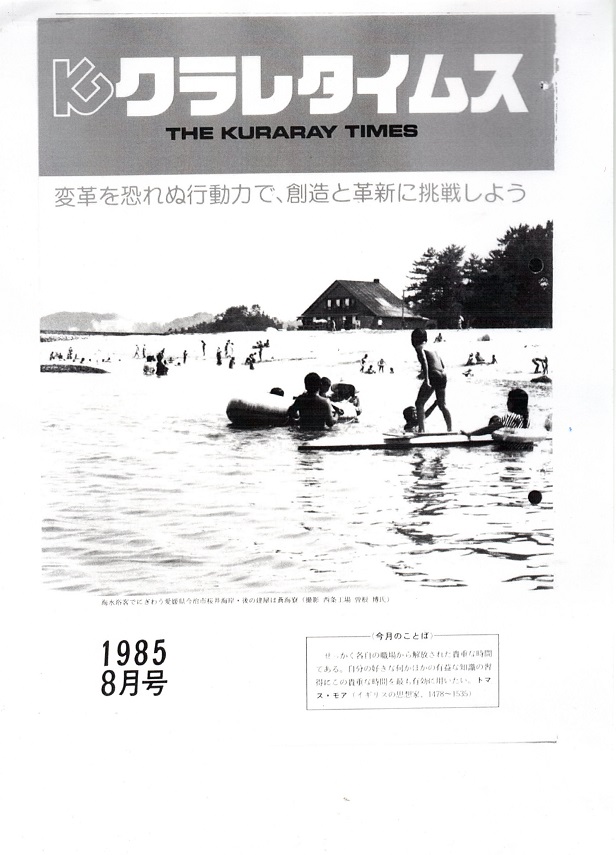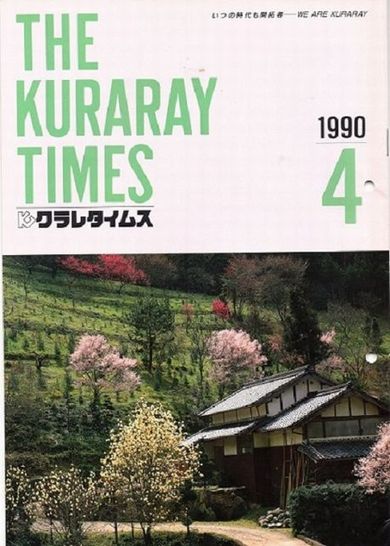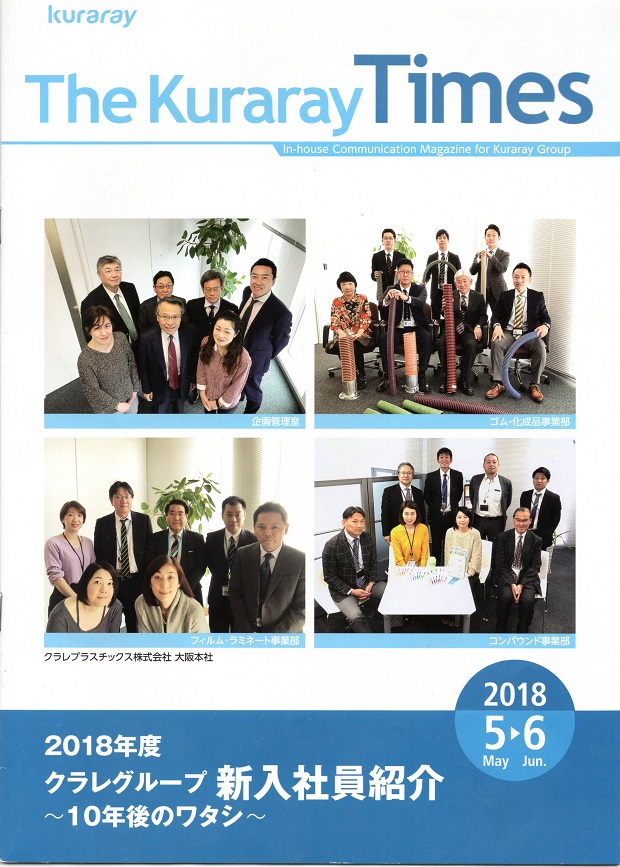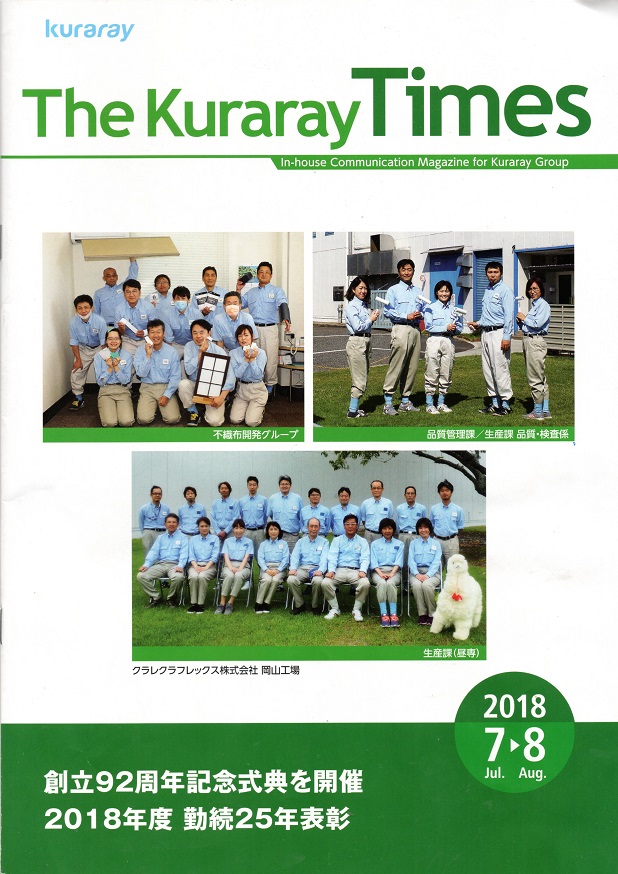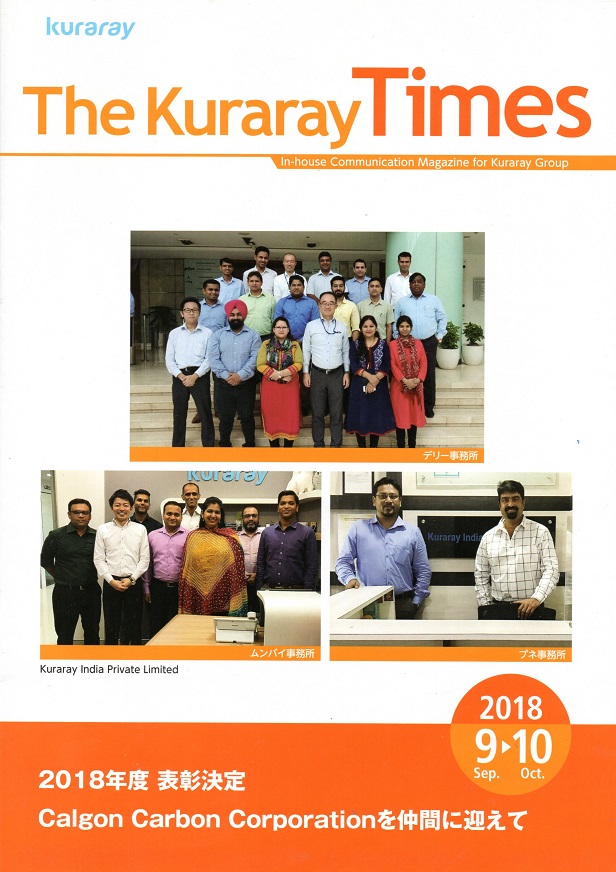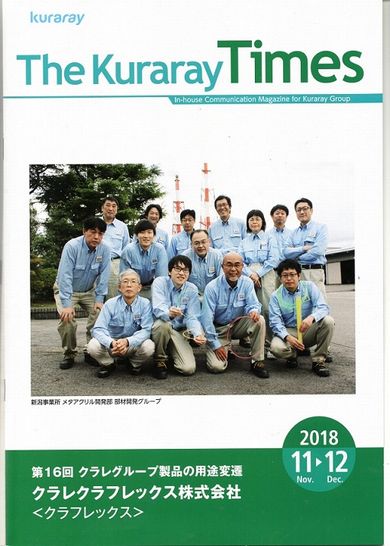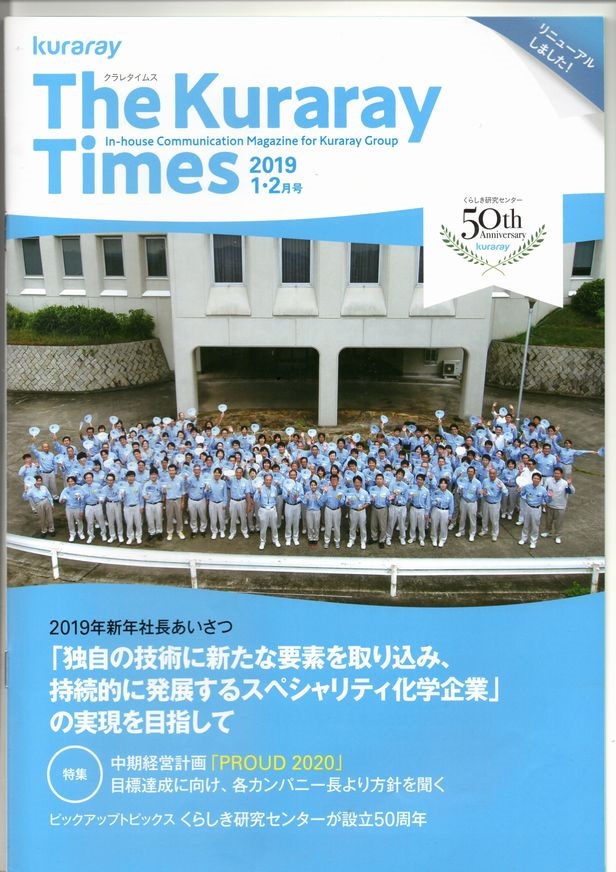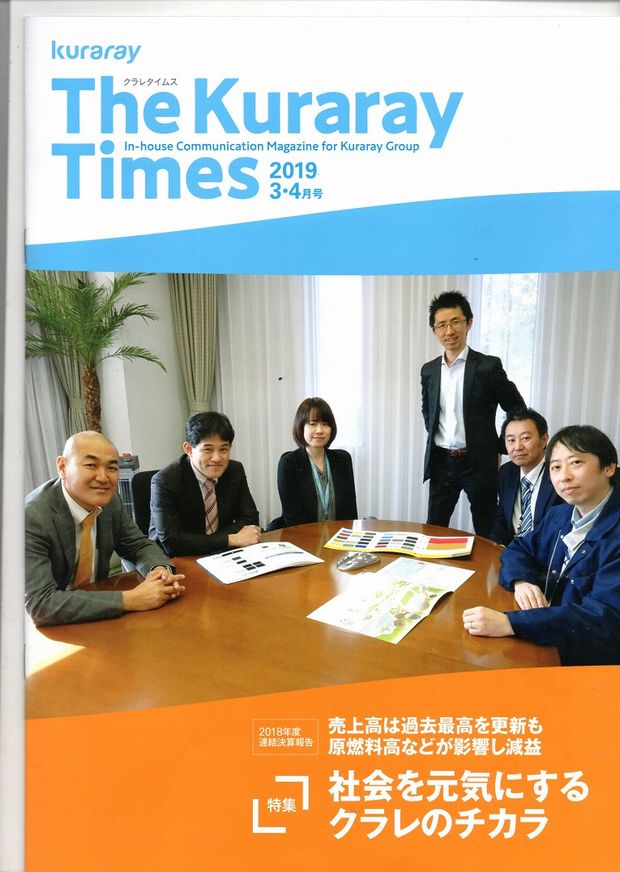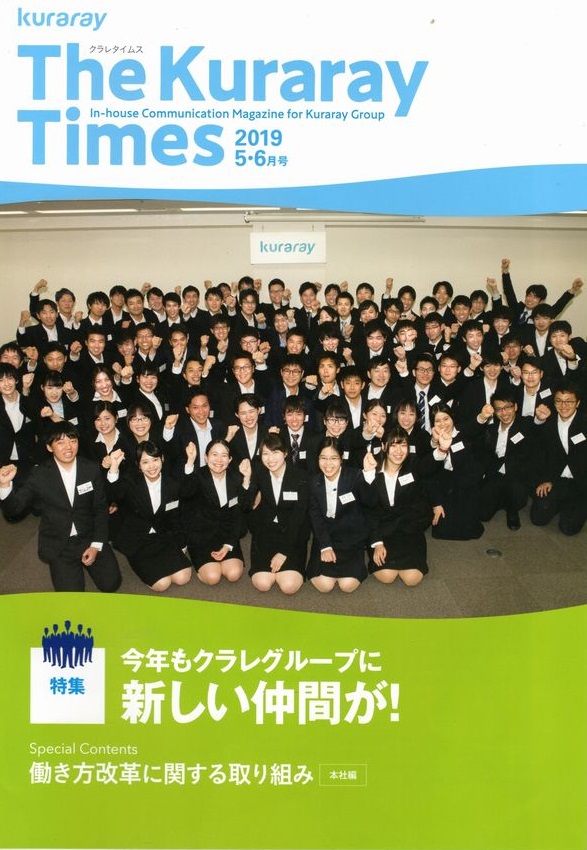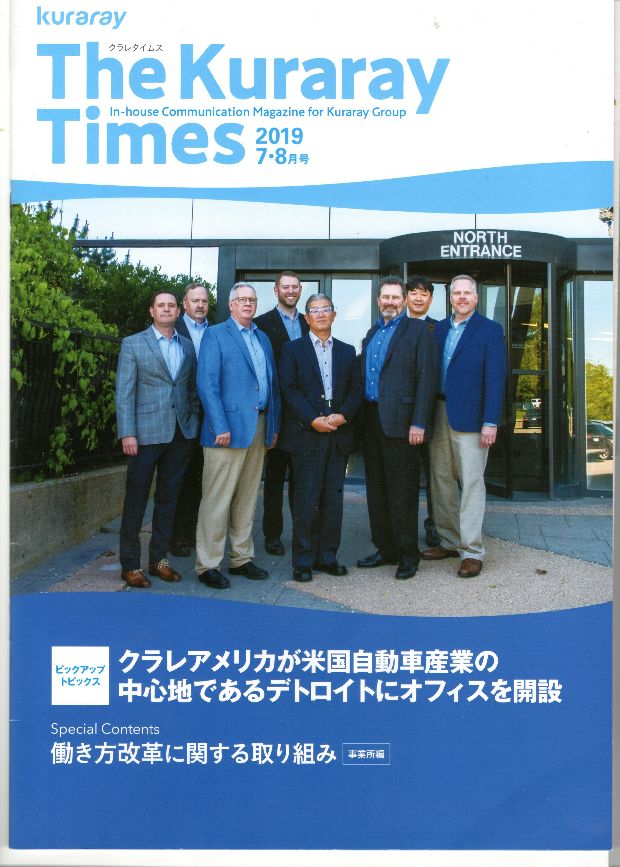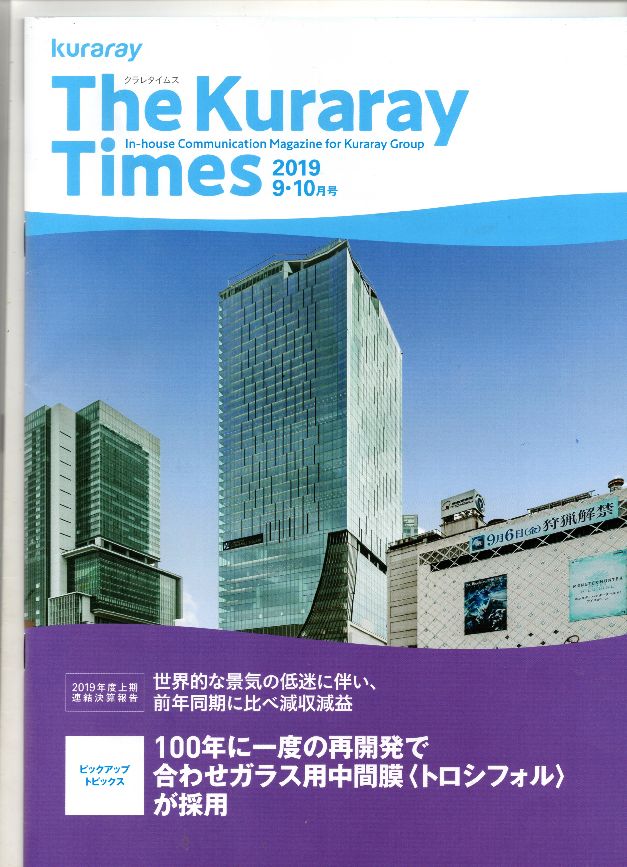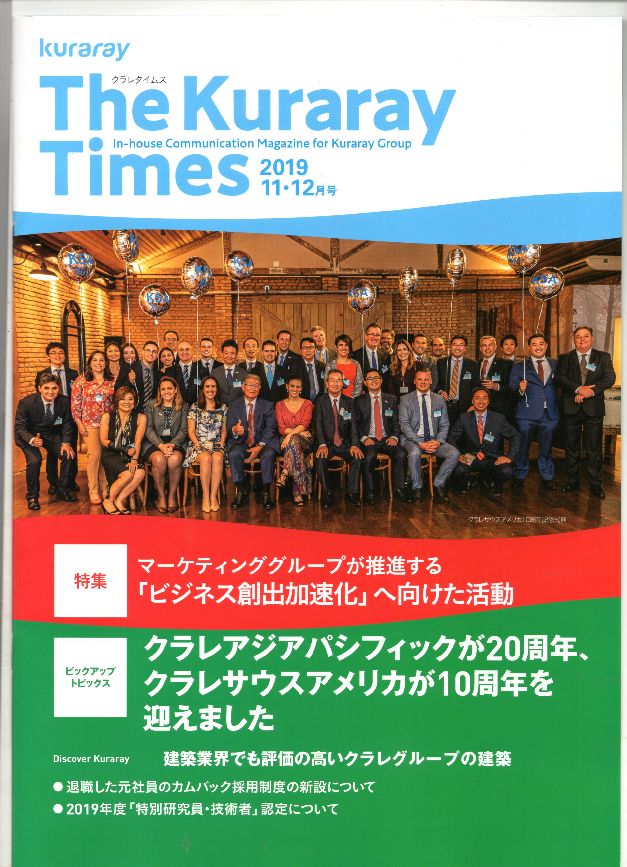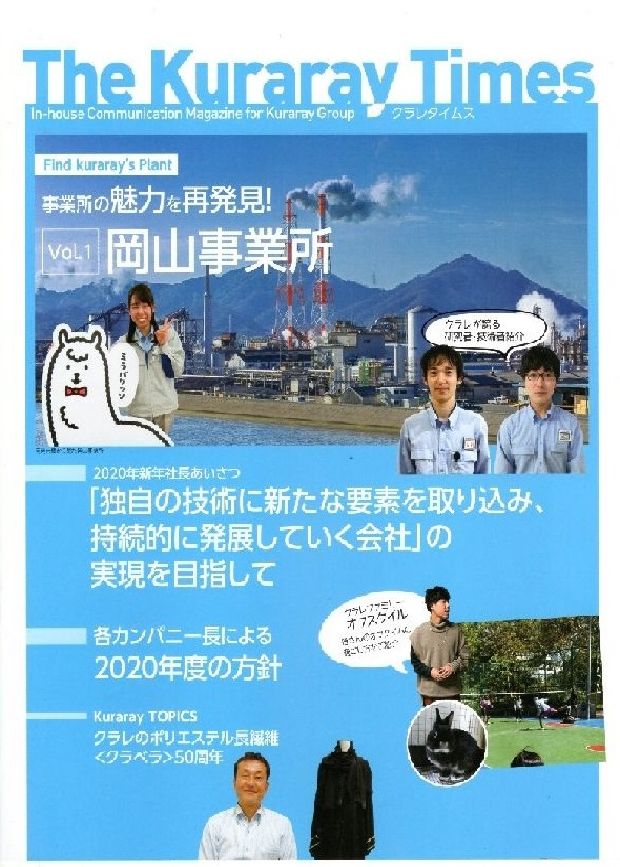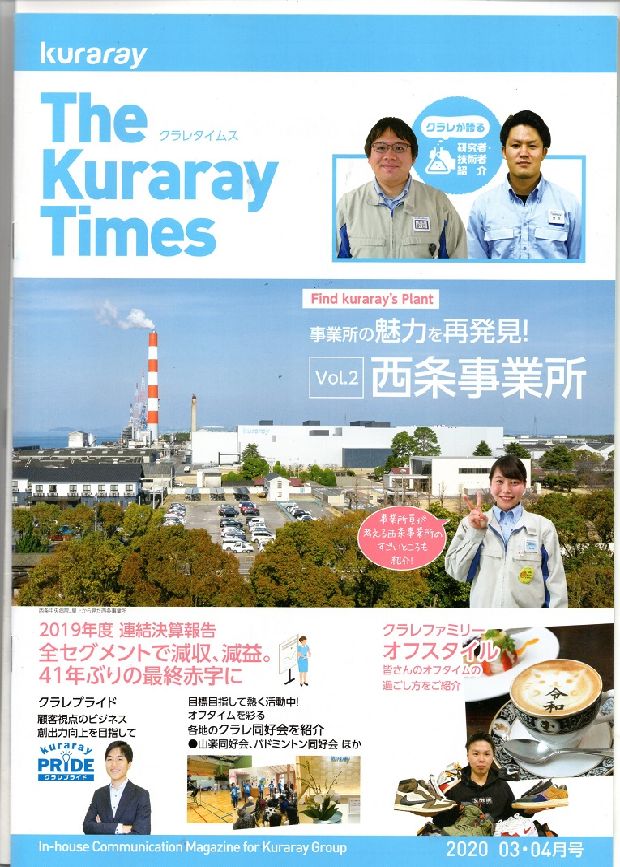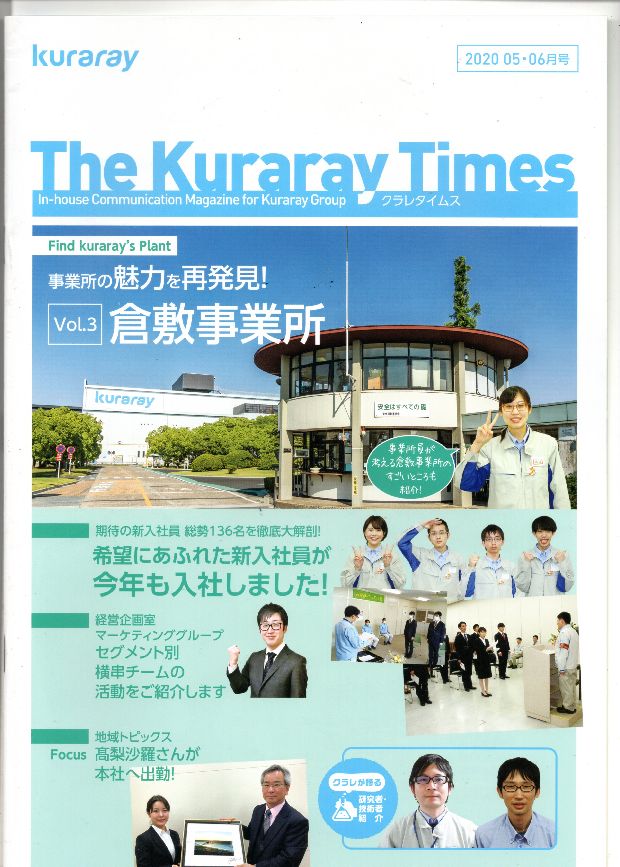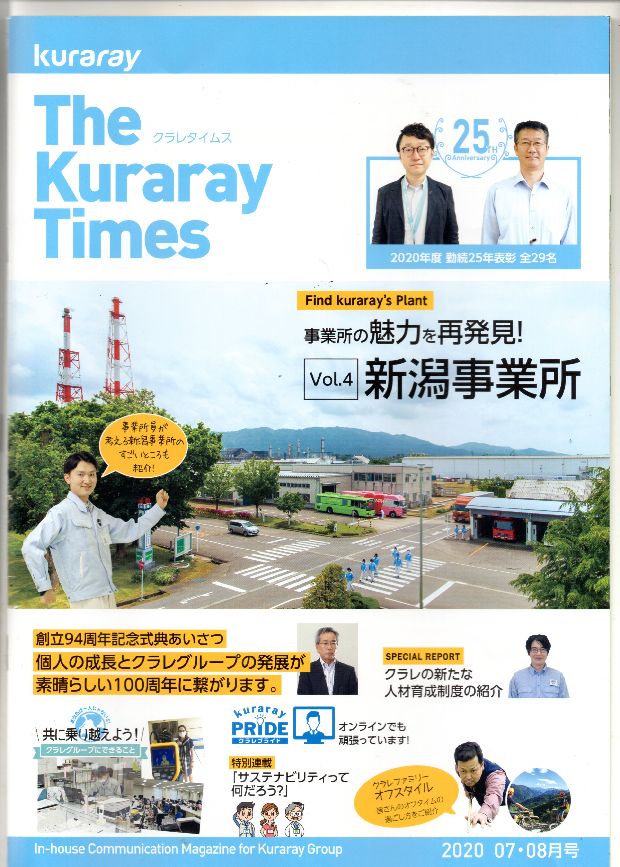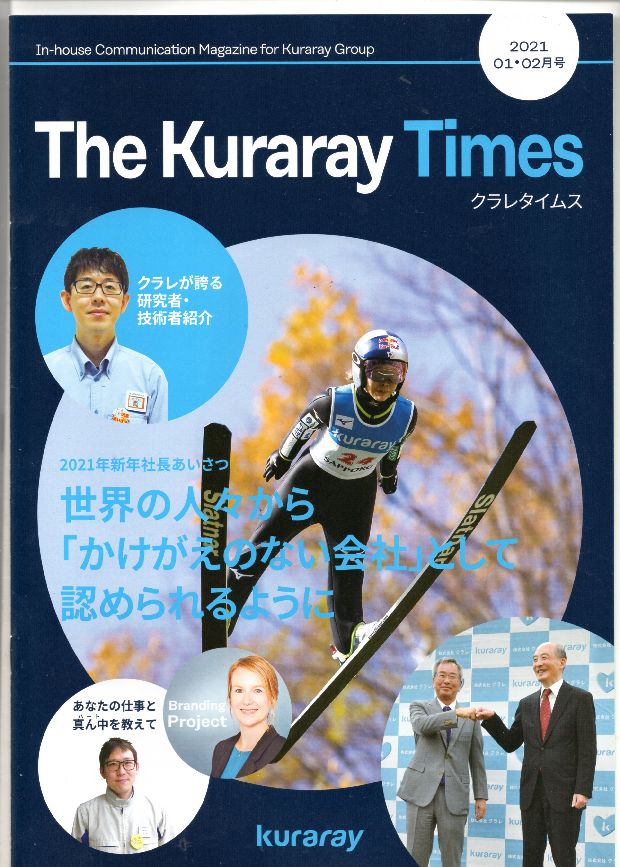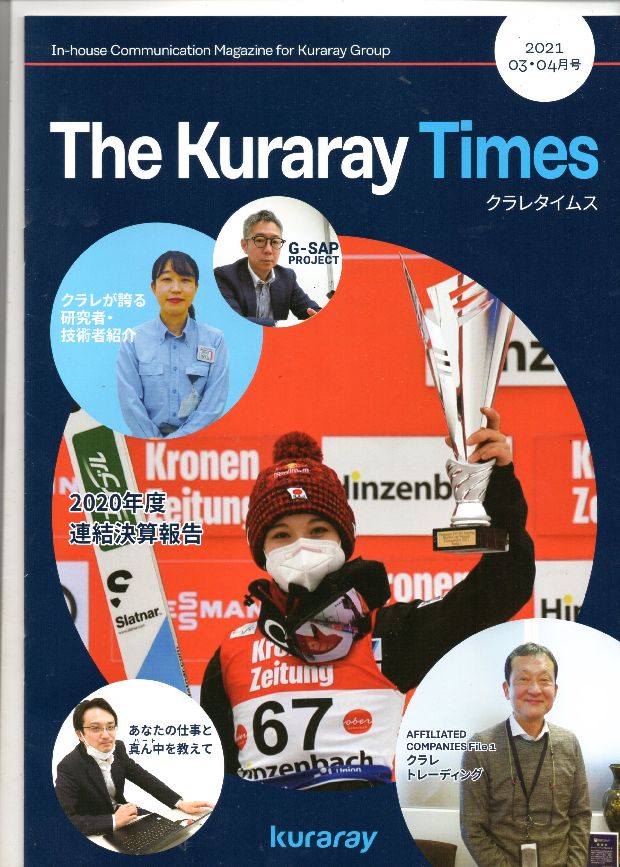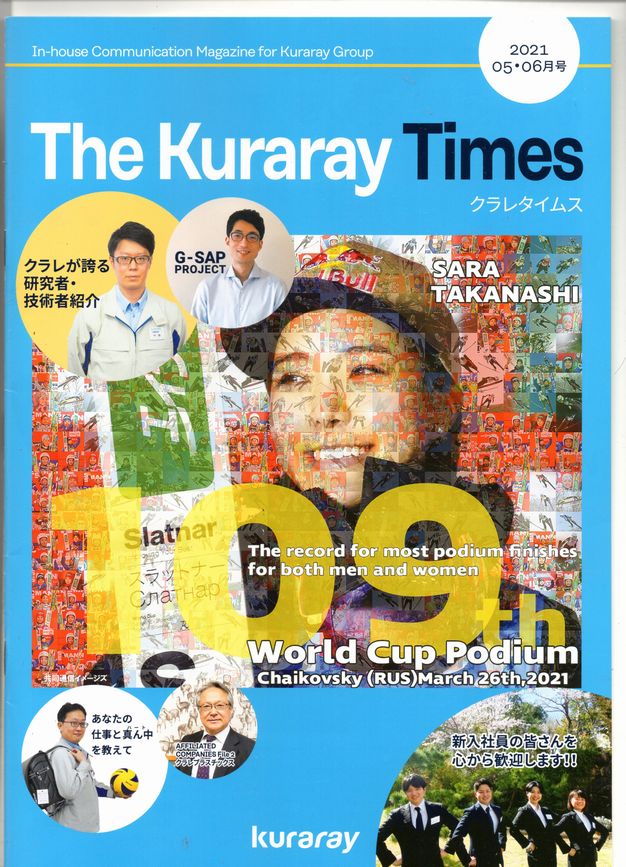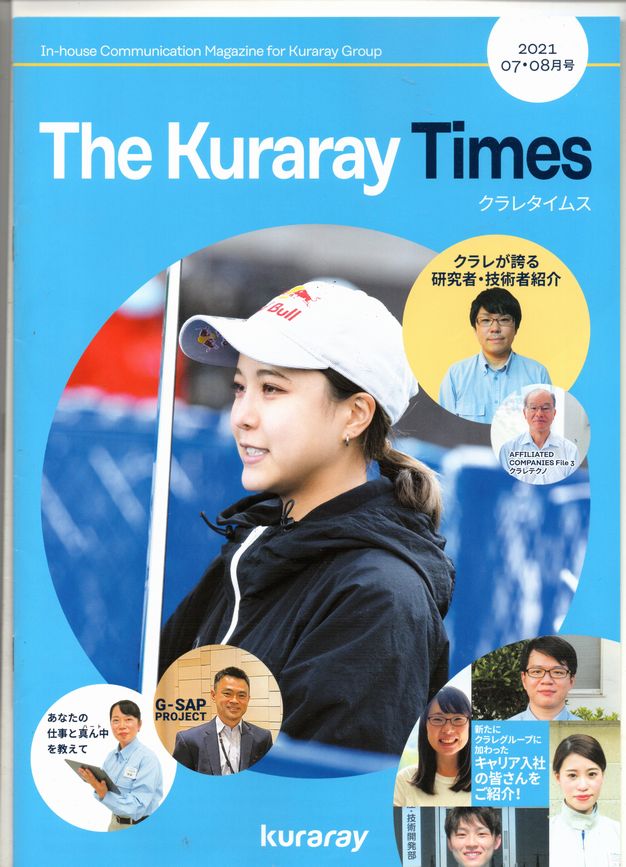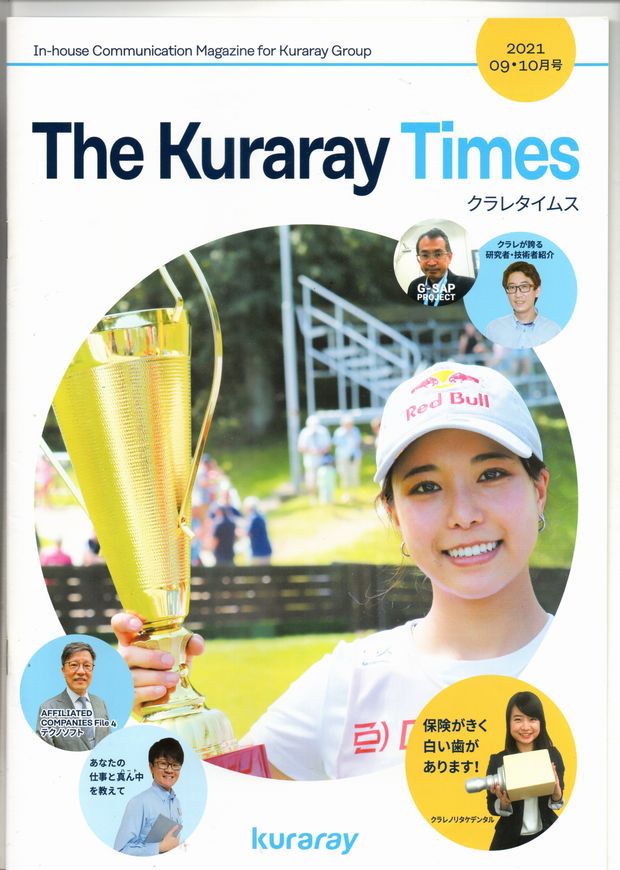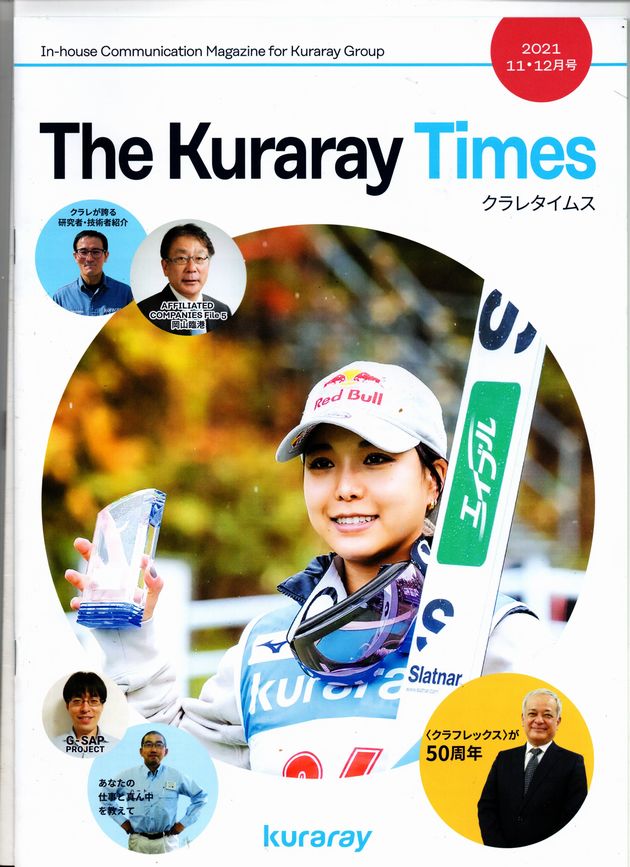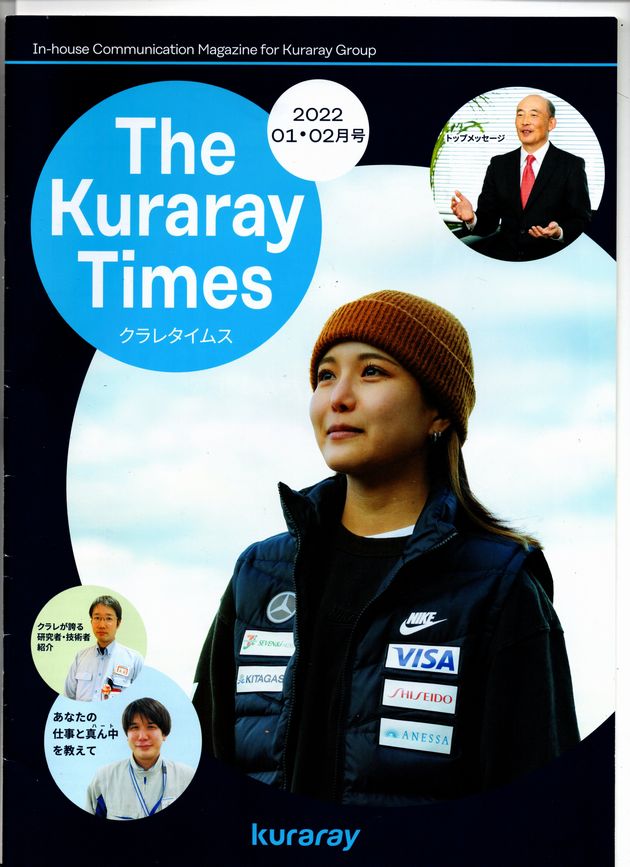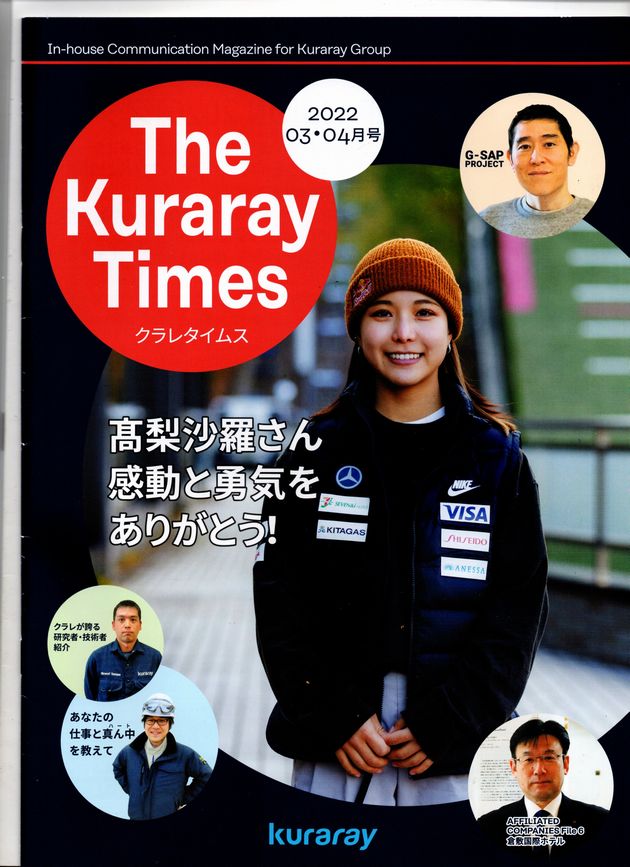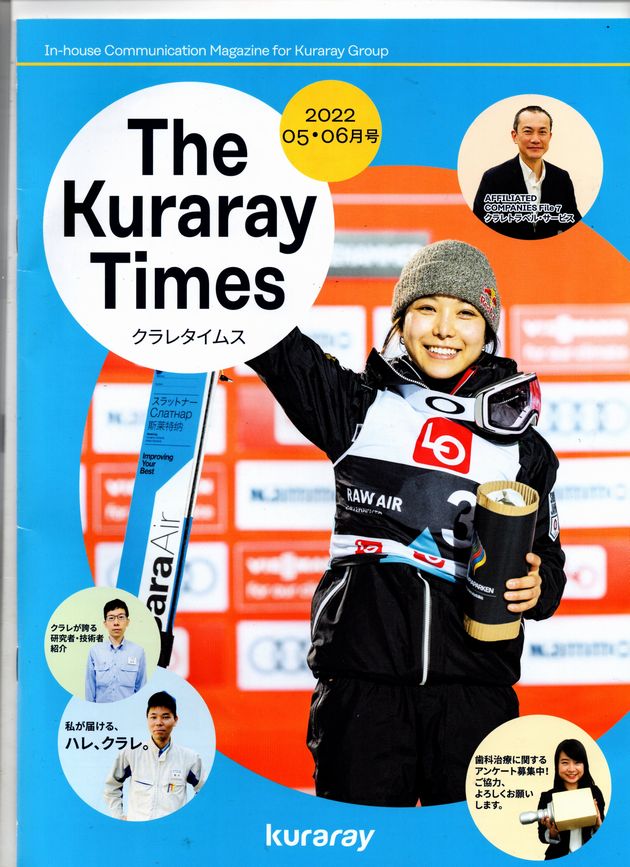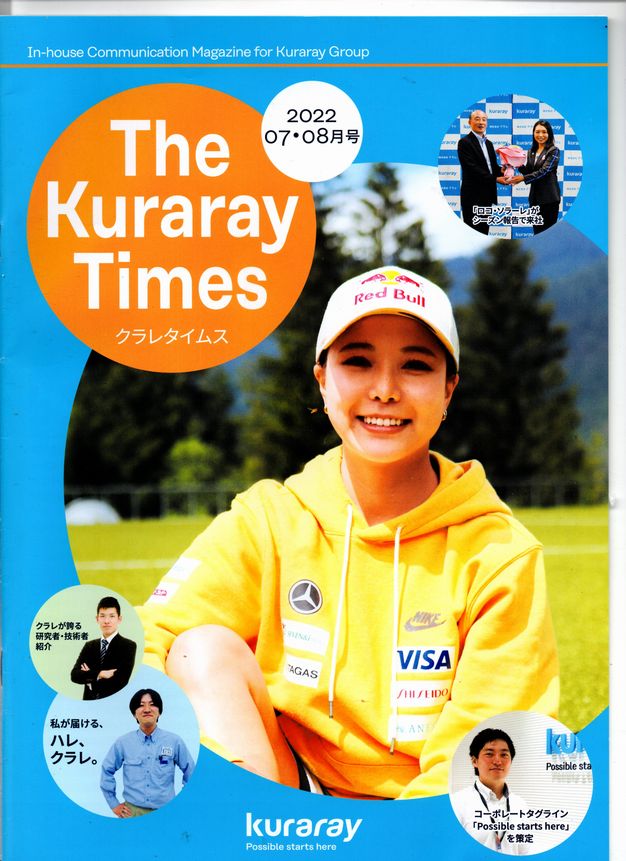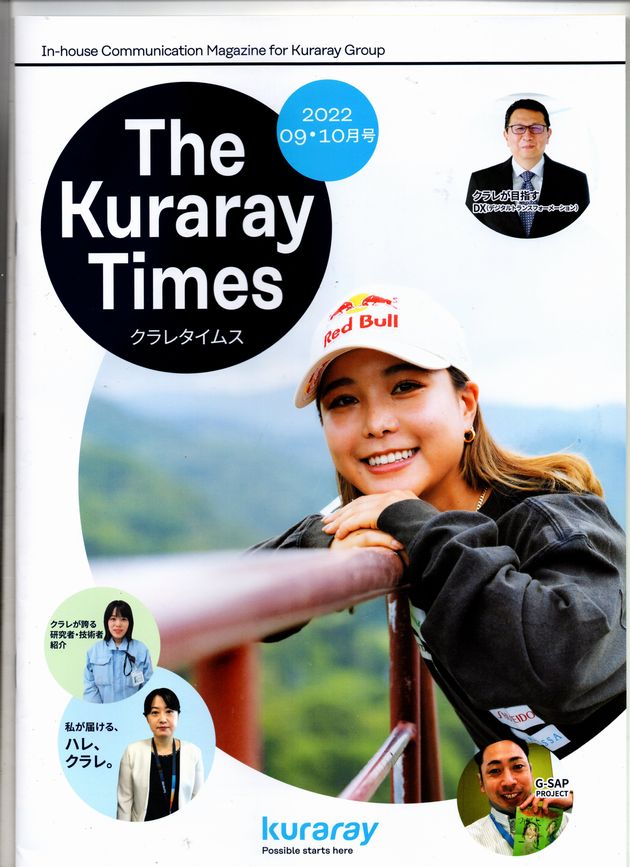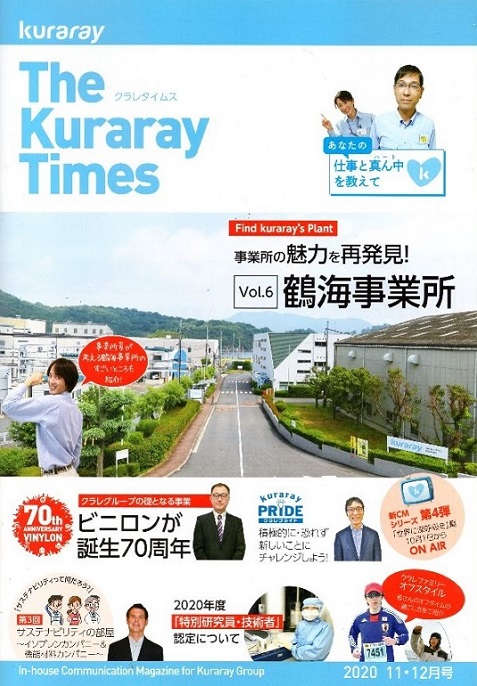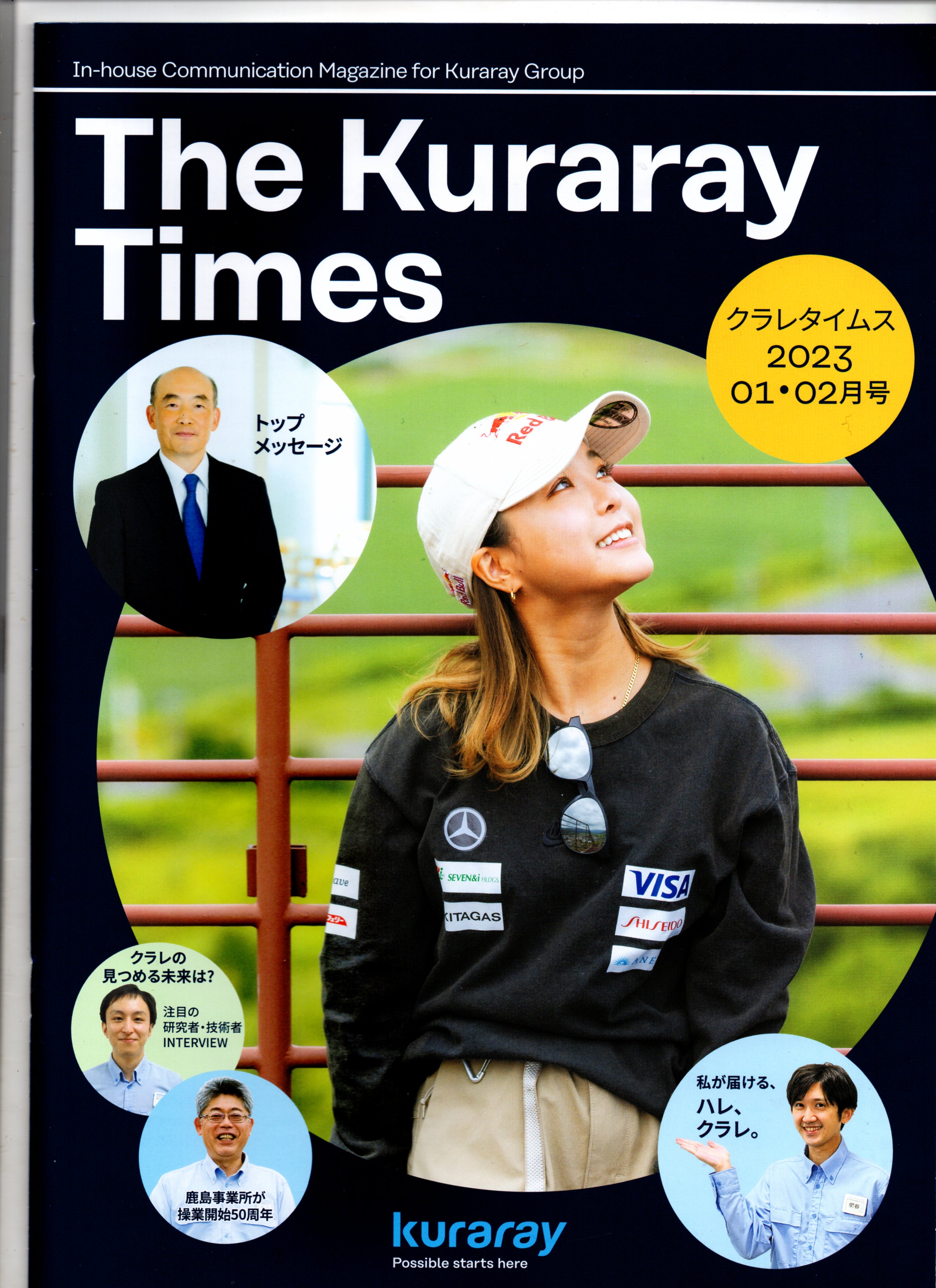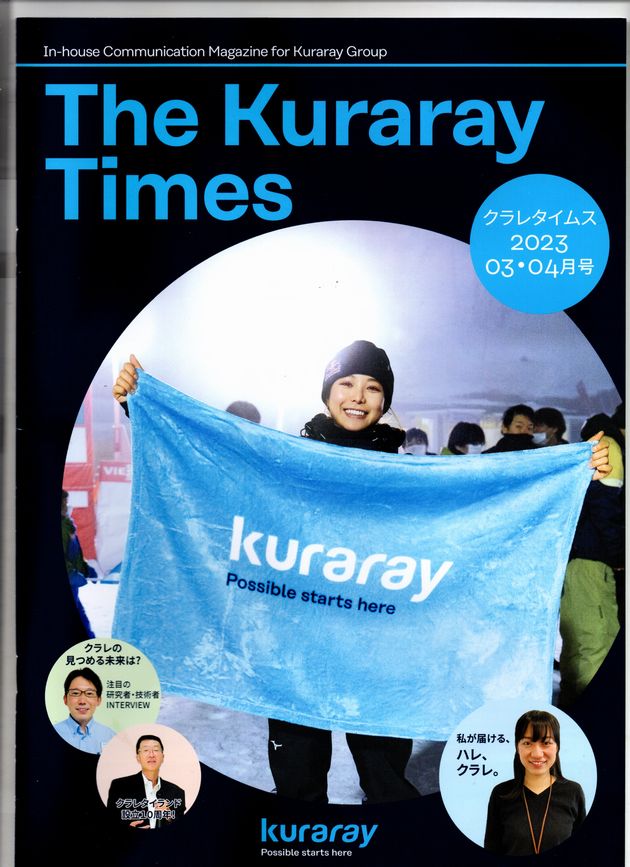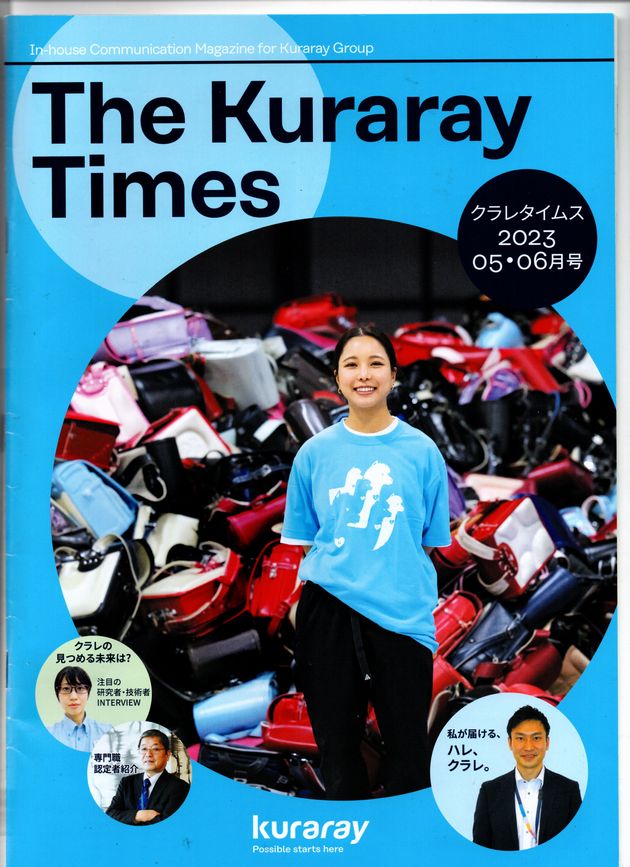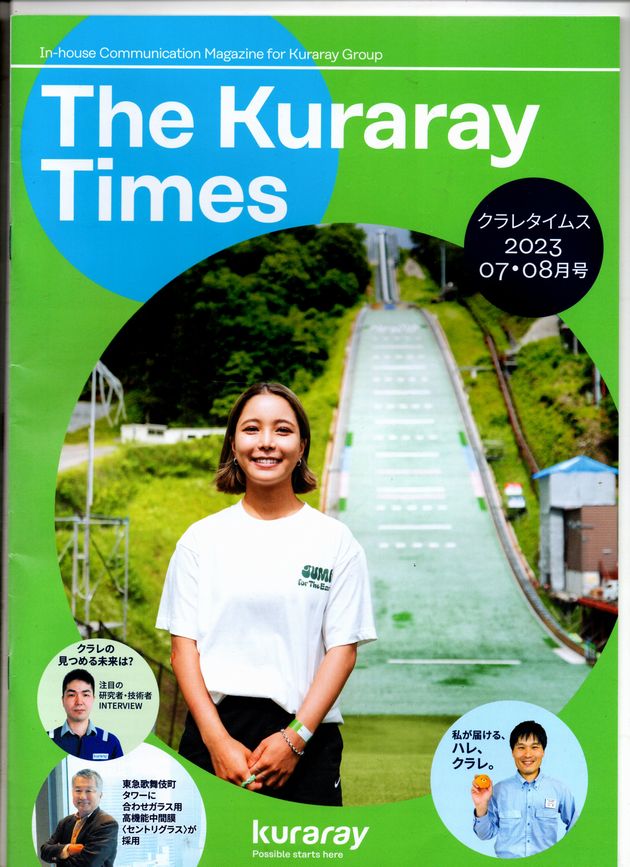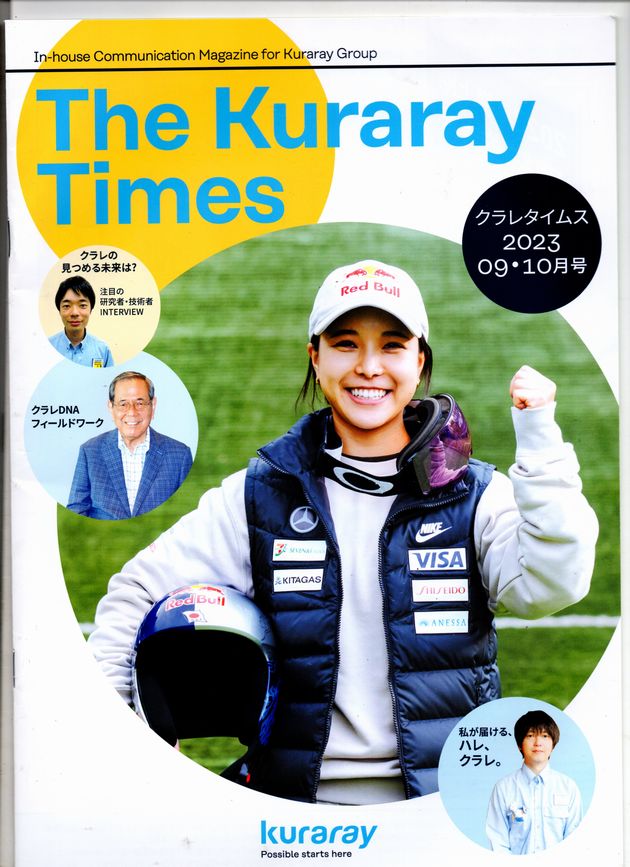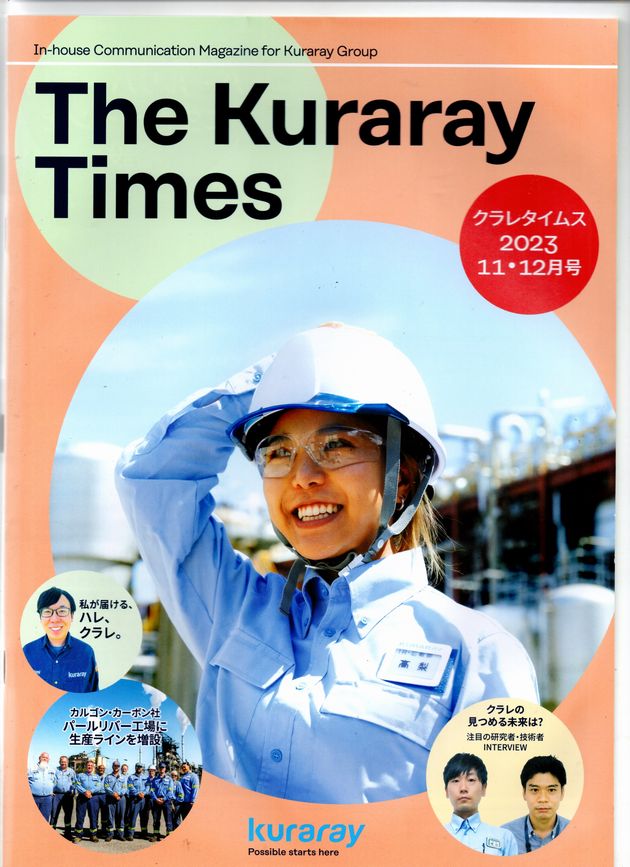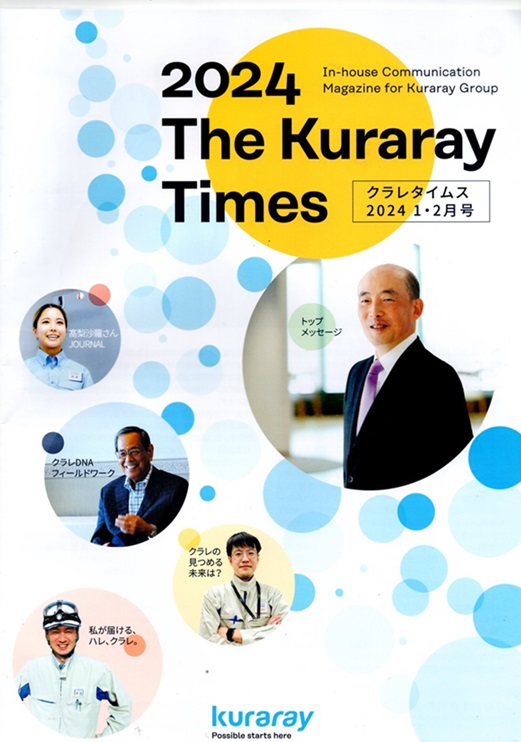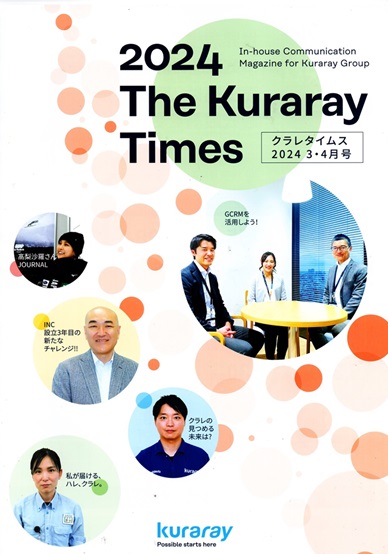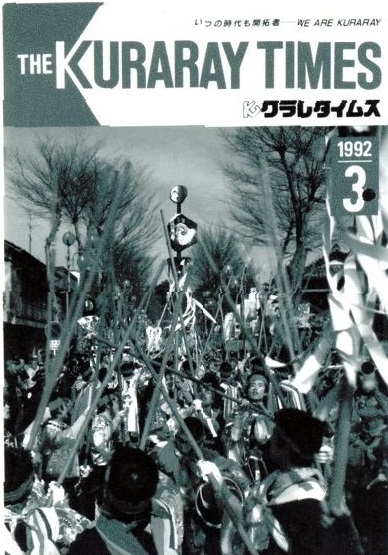
OB登場
~~~~~~~~~~~~
こんにちは インタビュー
お元気ですか
「自学自得」ハガキ通信を長くされているそうですが、始められたきっかけは。
クラレ研修所所に在任当時、通信教育中の研修生にハガキを書いていました。終了しても切磋琢磨を続けるために、定期的に通信してはと思っていました。
退職した一九八七年十二月から、ハガキ通信を始めました。表題「自学自得」は、当時の研修生の心構えです。毎月一日発信、以来四年間継続しました。現在は、ご交誼いただいている先輩、知人にも差し上げています。初めは人のために書いている思いもありましたが、今では逆に返信に励まされ、毎月の生活のけじめになっています。
▼いつもメモを持ち歩かれているそうですが……。
ポケット手帳にメモを挟んで持ち歩き、観察したこと、アイデアをその場で書き込みます。寝る時には、日記帳をまくら元に置いています。また新聞などの切り抜きも張り付けています。メモはワープロに入れ、ハガキ通信の材料などのしています。
▼現在、岡山理科大学付属高校にお勤めだだそうですね。
物理・化学・生物を担当しています。「若い人を教えていると若返るでしょう」と言われることが多いです。自分ではあまり実感はありませんが、そうなのかもしれません。
最初の半年は、未経験なことが多く、仕事の進め方で手探りの状態が続きました。時間の経つのも非常に遅く感じました。現在は、高校の実状も少し分かり、自分なりに工夫して勤めています。ワープロを覚えたり、英語検定、日本漢字能力検定に挑戦しています。
▼今後はどのようにお過ごしになりたいと思われますか。
以下五つのことを考えています。
一、ココロと体の健康を願う。
二、ハガキ通信が百号になったら自費出版したい。
三、外国放送のヒアリングができるようになりたい。
四、読書会などを作り、好きな本を読みたい。
五、ご交誼いただいている人と交流を続けたい。
ハガキ通信が、どのようなものか興味を感じられましたら、お手数ですが下記住所に往復ハガキを下されば、返信いたします。
〒七〇三
岡山市中区海吉一八七九-四
TEL 〇八六二-七七-〇六五九
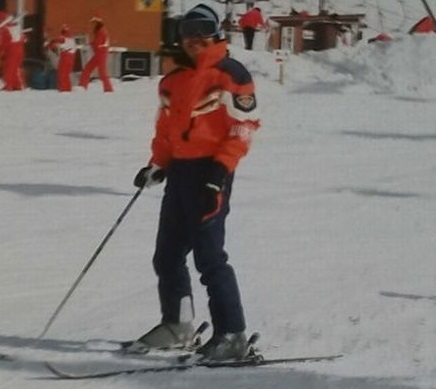 今年の1月25日、生徒たちと一緒に長野県志賀高原へ。
今年の1月25日、生徒たちと一緒に長野県志賀高原へ。
「略歴」
昭和2年生まれ64歳。
昭和25年岡山工場に入社。
中央研究所、倉敷工場に在籍し、繊維・化成品の研究に従事。
昭和58年クラレ研修所所長に就任、昭和62年退社後岡山理大学付属高校に勤務、現在に至る。
▼写真説明:取材に来られた藤田さんと私。付属高校図書館にて。
*04.02.05.日記より
1.クラレタイムス “こんにちは インタビュー お元気ですか” 本日投稿
取材のために岡山工場から藤田、後藤さんが来校。C1Bクラスでの授業風景と附属高校図書館で写真撮影。
藤田さん授業をみて非常に分かりやすいと思った。高校時代物理は好きでなかったが黒崎さんのように教えてもらっていれば好きになったかもしれないと言う。
関連1:基督教独立学園を訪れて:クラレタイムス85.4号。
関連2:越川春樹先生を訪ねて及び著作『人間学言志録』:クラレタイムス85.8号。
関連1:ハガキ通信(1)
★主要グループ拠点|kuraray-クラレ総務部:菅野さんのご協力で再現できました。有難うございました。
★1926年6月:倉敷絹織(株)創立、1939年8月:社内報「倉敷時報」を「連絡月報」と改称、1952年6月:社内報「倉敷レイヨン時報」(現・クラレタイムス)発刊、
クラレタイムス 1985 8月号の紹介記事から
心休まる倉敷――ニューヨーク・タイムズに紹介――
米国の代表的な新聞「ニューヨーク・タイムズ」に「東京から数時間の産業都市の一角に古く静かな日本が残っていると」として倉敷を訪問した同紙のスーザン・シーラ(Susan Chira)記者の紹介記事が大きく掲載されました。学生時代に戻ったつもりで訳してみて下さい.
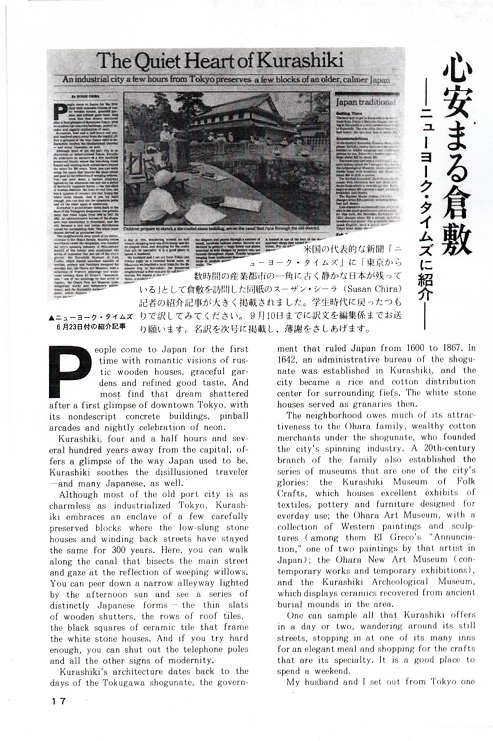 参考:▲ニューヨーク・タイムズ 1985年6月23日付けの紹介記事
参考:▲ニューヨーク・タイムズ 1985年6月23日付けの紹介記事
People come to Japan for the first time with romantic visions of rustic wooden houses, graceful gardens and refined good taste. And most find that dream shattered after a first glimpse of downtown Tokyo, with its nondescript concrete buildings, pinball arcades and nightly celebration of neon. Kurashiki, four and a half hours and several hundred years away from the capital, offers a glimpse of the way Japan used to be. Kurashiki soothes the disillusioned traveler ―and many Japanese, a well.
Although most of the old port city as charmless industrialized Tokyo, Kurashiki embraces an enclave of a few carefully preserved blocks where the low-slung stone houses and winding back street have stayed the same for 300 years. Here, you can walk along the canal that bisects the main street and gaze at the reflection of weeping willows. You can peer down a narrow alleyway lighted by the afternoon sun and see a series of distinctly Japanese forms―the thin slats of wooden shutters, the rows of roof tiles, the black squares of ceramic tile that frame the white stone houses. And if you try hard enough, you can shut out the telephone poles and all other signs of modernity.
Kurashiki’s architecture dates back to the days of Tokugawa shogunate, the government that ruled Japan from 1600 to 1867. In 1642 an administrative bureau of the shogunate was established in Kurashiki, and the city became rice and cotton distribution center for surrounding fiefs. The white stone houses served as granaries then.
The neighborhood owes much of its attractiveness to the Ohara family, wealthy cotton merchants under the shogunate, who founded the city’s spinning industry. A 20th-century branch of the family also established the series of museums that are one of the city’s glories; the Kurashiki Museum of Folk Crafts, which houses excellent exhibits of textiles, pottery and furniture designed for everyday use; the Ohara Art Museum, with a collection of Western paintings and sculptures ( among them EL Greco’s “Annunciation,” one of two paintings by that artist in Japan); the Ohara New Art Museum ( contemporary works and temporary exhibitions), and Kurashiki Archeological Museum, which displays ceramics recovered from ancient burial mounds in the area.
One can sample all that Kurashiki offers in a day or two, wandering around its still streets, stopping in at one of its many inns for elegant meal and shopping for the crafts that are its specialty. It is a good place to spend a weekend.
My husband and I set out from Tokyo one Friday night on a crowded bullet train. At Okayama we boarded a local train for the 20-minitue trip to Kurashiki; the preserved neighborhood is five minutes by cab from the station. We stayed at the Kurashiki Hotel, a modern hotel with beds that are long enough and wide for the average foreigner.
Our first sightseeing stop was the Museum of folk Crafts. Like the Frick in New York or the Gardner in Boston, It is diverse enough to stay interesting and small enough to stave off museum feet. The visitor enters the museum, which is installed in four former granaries, through a stone-paved alley, exchanges shoes for slippers and passes through a number of small, carefully laid-out rooms. Several are devoted to pottery―huge bowls and plates executed in bold designs by potters who are famous throughout Japan. Textile hangings ranging from traditional blue-and- white patterns to modern graphic designs cover the walls. The wooden chests and wardrobes called tansu line the passageways.
One room has a tatami alcove, complete with a brazier and pot of tea; another shows how a modern family might use many of the crafts on display in the museum, with tables set with hand-woven place mats, baskets, hand-blown glass and folk pottery. (The museum sells a number of examples of the crafts it displays; all are of very high quality and none are cheap. ) (中略)
By then it was lunchtime, and we are ready to investigation one of the city’s many inns. The Ryokan Kurashiki, in the corner of the main street, is not hard to find, but we approached it by the back way, coming upon its garden, which has an inviting stone path leading to a terrace framed by glass doors. There, a kimono-clad hostess us green tea, whipped frothy, with a traditional tea sweet to compensate for the slight bitterness of the tea. We were then led into the inn itself, to one of the guest rooms. Here, seated on tatami mats, we could look out on the garden as we awaited each course. First came a series of appetizers, served on ceramic plates―a single prawn, several slices of sashimi grouped around a flower, a small round of red dried mullet roe and pale fish paste, arranged in a checkerboard pattern. Next was grilled fish, chopped up with bamboo shoots and gobo―a vegetable that resembles celery but is less crunch―and sprinkled with a fiery red spice. The condiment looked beautiful with the brown and yellow leaf upon which the fish was served, and enlivened the whole meal. (中略)
Japan is famous for its refined porcelains and silks, but I prefer the rougher, more functional folk wares. Kurashiki is one of the most vital regional centers for these crafts, in a country that takes them very seriously. Its shops offer pottery , particularly brown fire-glazed ware; textiles, including table runners and place mats; baskets; woodblock prints; hand blown glass, an excellent selection of Japanese toys. (中略)
We found several good stores on Ebis Dori and Kurashiki Hon Dori, gaudu-looking shopping streets heading away from the main street past the Ohara Art Museum. Another good shop is in a complex called Kurashiki Ivy Square, which is reminiscent of something like Boston’s Quincy Market. The square is built around an old spinning of factory, with some interesting exhibitions concerning Kurashiki’s industry past. In the same complex is a small store that displays Chinese and Japanese scroll paintings. We found one lovely Japanese scroll and, after we had bought it, the proprietor invited us for tea and a long, friendly talk.
We found many people in Kurashiki, like so many throughout the rural areas of Japan, to be warm outgoing. That night, at a small yakitori bar, we begun talking to young couple, and before lobg their bottle of sake had been poured into our cups insted of thier own.
We had stumbled onto the yakitori bar as we were wandering through back streets where people really live. Such wandering is the best way to explore Kurashiki. Its main streets, while undeniably attractive, is a bit too crowded with souvenir shops and at times a bit too picture-postcard perfect; the alleys and narrow streets, where stone houses alternate with wooden ones and craft shops stand next to medicine shops, liquor stores and tatami-weaving shops, are far more satisfying.
And everywhere there are the characteristic vistas. Off one of back streets is a small hill with stone steps leading to a tori gate; climbing that hill, we looked down on the tiled roofs of old Kurashiki, the black tiles casting shadows on the stark white granaries. Concrete office buildings and apartments lined the periphery, but within the circle the illusion persisted. Modern Japan remained outside, at least for a few moments.
昭和60年の記事である。私も倉敷に住んでいました。倉敷美観地区の周辺は今も変わりなくその美しさと日本のよき家並み、風景を残しています。
しかし、現在(平成21年)は日本の地方都市にもれず、倉敷市全体の雰囲気は同調しているように思えます。その象徴の一つとしてチボリ公園の廃園が決まり、その後の利用計画が関係者により模索されています。
倉敷美観地区への観光のほかにも、時間が許せば少し郊外に、高梁川辺の散策、酒津(さかず)あたりの落ち着きも心を休めてくれるでしょう。
■参 考
1, rustic=You can use rustic to describe things or people that you approve of because they are simple or unsophisticated in a way that is typical of the country.
2, nondescript=If you describe something or someone as nondescript, you mean that their appearance is rather dull, and not at all interesting or attractive.
3, pinball=(日本の)パチンコ。
4, Arcade=アーケード
5, Enclave=孤立した地域。An enclave is an area within a country or a city that is inhabited by people of a different nationality or culture from the inhabitants of surrounding country or city. 天領をいみするのか?
6, low-slung=Slung is the past tense and past participle of sling. If you sting something somewhere, you throw it there carefully.
7, weeping willow=A weeping willow is a type of willow tree.
8, slats=Slats are the narrow pieces of wood, metal, or plastic in things such as Venetian blinds or cupboard doors.
9, fiefs=in former times, a fief was a piece of land given by their lord, to whom they had a duty to provide particular services in return.
10, granaries=you can refer to the part a country or region where large amount of corn is grown as a granary of that country.
11, Annunciation=In Christian belief, the Annunciation was the announcement by the Archangel Gabriel to the Virgin Mary that she was going birth to the son of God.
12, Stave off=If you stave off something bad, or if you stave it off, you succeed in stopping it happening for a while.
13, Executed=When someone executes work of art, they make or produce it, using an idea as a basis.
14, Alcove=an alcove is a small area of a room which is formed by one part of wall being built back than the rest of the wall.
15, Brazier=A brazier is a large metal container in which coal or charcoal is burned to keep people warm when they are outside in cold weather, for example because of their work.
16, hand-blown=blow: If you blow, you send out a stream of air from your mouth.
17, kimono-clad=clad: If you are clad in particular clothes, you are wearing them; a literary use.
18, whipped frothy=whip: If something or someone whips somewhere, they move there or go there very quickly. Frothy: A frothy liquid has lots of bubbles on its surface.
19, prawn=In British English, a small shellfish, similar to a shrimp, which can be eaten. The American word is shrimp.
20, mullet roe=A mullet is a small sea fish that people cook and eat. Roe is the eggs or sperm of a fish, which is eaten as food.
21, checkerboard =A checkerboard pattern is made up equal–sized black and white squares of two different colours, usually black and white.
22, shoot=Shoots are plants that are beginning to grow, or new parts growing from a plant or tree.
23, crunch=If you crunch something hard, such as a sweet, you crush it noisily between your teeth.
24, sprinkled=If you sprinkle a thing such as liquid or powder, you scatter the liquid or powder over it.
25, fiery=If you describe something as fiery, you mean that it is burning strongly or contains fire; a literary use.
26, condiment=A condiment is a substance such as salt, pepper, or mustard that you add to food that you add to food when you eat it in order to improve the flavour.
27、enliven =To enliven events, situation, or people means to make them more likely or cheerful.
私が参考にした辞書
collins
COBUILD
ENGLISH
DICTIONARY
平成二十一年九月二十日
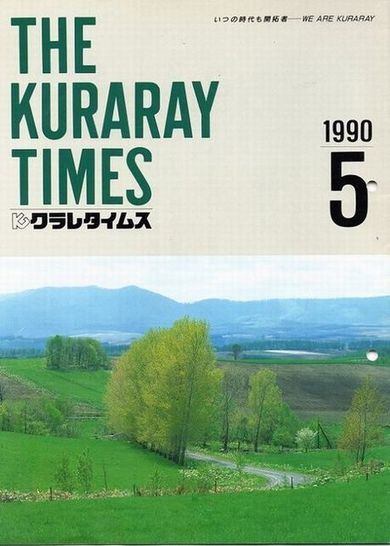 「わが青春の思い出 初めてのスキー単独 クラレタイムス 1990年5月
「わが青春の思い出 初めてのスキー単独 クラレタイムス 1990年5月
専務取締役 安 井 昭 夫
何かに熱中できた時を青春というなら、私の場合大学での九年間だろう。中学、高校時代は戦中、戦後の混乱で何もできなかった。京都には昔ながらの街があり、大学もそのままで、ここに来て学問をやろうという気になった。特に後半の五年間は、装置の組み立てと実験に寝食を忘れた学究生活で、研究の面白さがわかった時代であった。
その中で寸暇をみつけては、山とスキーに精を出した。特に、春の学会後の春山スキーを計画する楽しさは、たまらなかった。
一九五六年の三月末、乗鞍岳→平湯温泉→安房峠→上高地→長塀山(ながかべやま)のコースで、初めてのスキー単独行きをやった。乗鞍岳では、アイゼンもきかない硬い氷と猛吹雪に泣かされ、平湯への道を見つけた嬉しさに三〇〇〇メートルの恐ろしさを知った。徳沢では、マッターホルン北壁の日本人初登攀者の芳野満彦(1931年:昭和6年11月8日 - 2012年:平成24年2月5日:登山家)さんと二、三日一緒だった。長壁山では雪にうずもれて見た槍、穂高の稜線に舞上ったすさまじいラウフェン(雪煙)が忘れられない。
スキーでは、よく「前傾」が大切といわれる。急斜面では転倒をこわがると必ず転ぶ。成功には、技術と斜面に飛び出して前傾する勇気が必要だ。スキーを始めて、十年くらいかかって悟った青春の人生訓である。
平成三十年八月十日追加。
Global 100
私は「世界で最も持続可能な100社」など知りませんでした。早速インターネットで調べてみましたところ下記の記事がありました。
■「世界で最も持続可能な企業」「グローバル100」の発表 : CSRニュース ...
日本の企業が100社の中に13社がランクインしていました。
素直に日本の企業も頑張っているなとの印象をいだきました。それぞれの企業は理念に徹して経営していると拝察いたしました。100年に一度の経済危機に直面している昨今、日本の企業がその立ち直りに貢献していただきたいものと切に願望いたしました。
平成二十一年四月十九日
KURAY TIMES 11.12Nov.Des,2017
炭素材料事業を第3のコア事業へ
米国活性炭最大手Calgon Carbon Corporation を買収
12017年9月21日、東京八重洲ベルサール(東京都内)で米国Calgon Carbon Corporation(以下Calgon Carbon社)の買収について、記者会見を行いました。今回の買収は、重点戦略領域である「水・環境」「エネルギー」分野での事業拡大を目指すものです。買収金額は約1.200億円で、当社過去最高額となり、会見に臨まれた伊藤さんは「今回のM&Aは第3のコア事業の構築という点で、当社にとって大きな意義を持つ」と説明されました。
本買収は2017年末までに完了予定です。
当社は、岡山県(鶴見)と中国、フィリツピンに生産拠点を有し、浄水器、空気清浄機、窒素分離、キャパシタなどのハイエンド領域を中心に、幅広い用途で高機能活性炭を中心とした事業を展開しています。一方Calgon Carbon社は世界7カ国に生産拠点を、世界16カ国に販売拠点を有する活性炭世界大手です。浄水、工業排水・ガス処理、食品・飲料精製など産業用途に強みを持ち、北米・欧州を中心に事業を展開しています。両社の事業は、主要販売地域や主要用途などにおいて相互補完関係にあり、今回の買収により、当社は石炭・やし殻・木質原料を持つ総合活性炭メーカーとなります。買収完了後は、炭素材料事業をビニルアセテート事業、イソプレン事業に次ぐ当社第3のコア事業とすべく、買収シナジー効果の早期発現を目指します。
補足:中国の生産拠点は、中国の内部に位置する寧夏回族自治区にある活性炭生産工場:可楽麗化学(寧夏)環境化工有限公司。
KURAY TIMES 1.2Jan.Feb,2018
Kuraray Korea, Industrial Service Medal 受賞
Kuraray Koreaは、このたび<2017 Foreign Company Day >におい、Industrial Service Medal 受賞てしました。同賞は、韓国外国企業協会(FORCA)によって毎年選ばれるもので、外国企業による外資投資が表彰対象となります。PVB事業部URSAN工場のPVBライン投資による経済効果、雇用創出したことが評価され、受賞に至りました。授賞式は11月7日 Memorial Seoul ホテルで執り行われ、PVB事業部長の天津さんが出席されました。
今回の設備投資は、当社の自動車用途の拡大を目指す戦略的投資であり、成長市場であるアジアに立地する韓国URSANでフィルムラインを増強することで、多様化する顧客ニーズに応えて現地供給体制を整備し、さらなる事業拡大を図ります。
KURAY TIMES 3.4Mar.Apr,2018
2017年度 連結決算報告
営業利益、経常利益、当期純利益のすべてで、3年連続過去最高を更新
2月14日に2017年度連結決算を発表しました。同日、マスコミおよび投資家向けに決算説明会わお開催しましたので、その概要を紹介します。
*詳しくは、クラレホームぺージに説明資料と説明会の動画を提供しますので、ぜしご覧ください。(記事中億円未満は四捨五入)
*中期経営計画「PROUD 2020」の詳細については、2月中旬に配布した「クラレタイムス」別冊をご覧ください。
決算の概要
2017年度 連結決算業績について
当社連結会計年度(2017年1月1日~2017年12月31日)の業績は、売上高は5,184億円(前年度比6.9%増)、営業利益は751億円(同10.7%増)、経常利益は730億円(同10.3%増)、 当期純利益は536億円(同32.7%増)となりました。
世界経済は、不安定な政情が経済へ与える影響が懸念されましたが、消費、投資ともに引き続き拡大基調で、概ね順調に推移しました。日本経済においても、順調な輸出を背景に企業収益が伸長したことに加え、雇用状況の改善が進み、緩やかに景気の上向きが続いた一年となりんました。
当社の業績は多くの事業で好調な販売が続き、原燃料価格の上昇による製造原価のアップも吸収した結果、前年度比で増収、増益になりました。また、営業利益、経常利益、当期純利益のすべてで、3年連続過去最高を更新しました。
KURAY The Kuraray Times 2018 5~6
2018年度 入社式を開催
4月2日(月)、東京本社でECコース新入社員74名の入社式を行いました。
社長の伊藤さんから新入社員を代表して池田安奈さんに採用通知書が授与され、晴れてクラレグループの仲間入りをされました。
伊藤さんは訓示の中で、女子スキージャンプの高梨選手について触れられ、平昌五輪で銅メダルを獲得し、ワールドカップでは通算55勝の記録を打ち立てた高梨選手ですが、突然世界の舞台で活躍したわけではなく、一歩一歩成長を目指して日々努力を続けてきた結果だと語られました。そして、新入社員の皆さんに「将来、高梨選手のように世界の舞台で戦えるクラレパーソンになって下さい。皆さんならきっとそうなれるでしょう」と激励されました。
最後に、新入社員を代表として、小林新さん、福山美鈴さんが挨拶されました。小林さんは学生時代に培った、人との信頼関係を深めるコミュニケーションスキルで、福山さんは大学時代に挑戦したマラソンで培った諦めない心で、共に社業に貢献していくと決意表明しました。
募集職種
技術系:(研究開発/商品・用途開発・生産技術開発/設備技術開発・知的財産・技術営業)
事務系: (営業・スタッフ)
応募資格
2018年3月までに大学卒業予定で職歴の無い方。ECコースへの応募をご希望される方
※ECコースとは:全社的な基幹業務(組織マネジメント、高度な専門的知識を要する職務)を担当することを求められるコースです。
業務を着実に遂行し、事業を支えることを求められる「FLコース」採用については事業所採用のページをご覧ください。
KURAY TIMES April,2009 「クラレタイムス 2009年 4月号」をページを繰りながら読んでいました。読み終わり、ふと、この号の裏表紙を見ると下記の文字列が印刷されていました。
Most Sustatinable Corporation in the World
「世界で最も持続可能な100社」
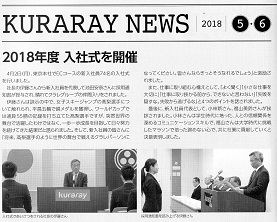 また、仕事に取り組む心構えとして、「よく聞く」「小さな仕事を大事に仕事に取り掛かる前から、できないと言わない」「失敗を隠すな。失敗から逃げるな」と4つのポイントを話されました。
また、仕事に取り組む心構えとして、「よく聞く」「小さな仕事を大事に仕事に取り掛かる前から、できないと言わない」「失敗を隠すな。失敗から逃げるな」と4つのポイントを話されました。
